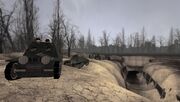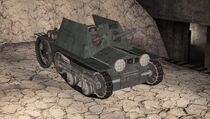Development
In December 1380, Morris received an order from the Vladivets Armiya which called for a new type of armored fighting vehicle. This massive order instantly elevated the 5 year old company to the position of most influential producer of armored fighting vehicles in all of Vladivets. The vehicle was to be light, all terrain, self-sufficient in combat and most importantly, cheap to produce.
The first prototypes of the Morris Mark I had a drivetrain similar to the armored cars the company was used to producing. The prototypes were slow, prone to breakdowns and had a low carrying capacity which allowed for relatively thin armor. It wasn't until 1383 when Morris decided to use a caterpillar track instead of the front wheels. This modification cost the Mark I in speed, but it did provide the desired all terrain capability and carrying capacity. The chassis was equipped with a fixed weapon assembly, carrying a 37mm short barrelled cannon for long range precision engagements and a 60mm mortar for infantry suppression. The crew was protected by a maximum of 35mm thick steel, which was more than enough to counter machinegun fire and artillery shrapnel at the time.The Morris Mark I prototypes concluded testing in 1785 and entered full scale production in that same year.
 A Column of Mark I's, Triumphantly crossing the border between Podotsk and the UNN. |
Morris Mark I
When the United Nation of Novourov (UNN) invaded Podotsk and Minegorod in the winter of 1411, the Morris Mark I and Morris Mark II made up the bulk of the UNN armored ground forces. Their success didn't come from the specifications of the vehicles. The mark I in particular had mediocre armor and armament, and it was vastly outperformed by the ZM.L-1/37 of the Zhinapan Army. The mark I's strength was its simplicity and numbers. It was a cheap, easy and fast to produce vehicle, it had reliable performance and was easy to repair in the field. Its 60mm mortar and 37mm cannon made it self sufficient in combat and able to attack both infantry and emplacements. it could be operated by a two man crew and required no specific training as its controls were very similar to a normal automobile. The ZM.L-1/37 was a fearsome opponent, but during the time of the invasion the Zhinapan light tanks were too wide spread to offer any real resistance. The UNN deployed over 2000 mark I's in the annexation of Podotsk and Minegorod, half of which were lost in combat.
